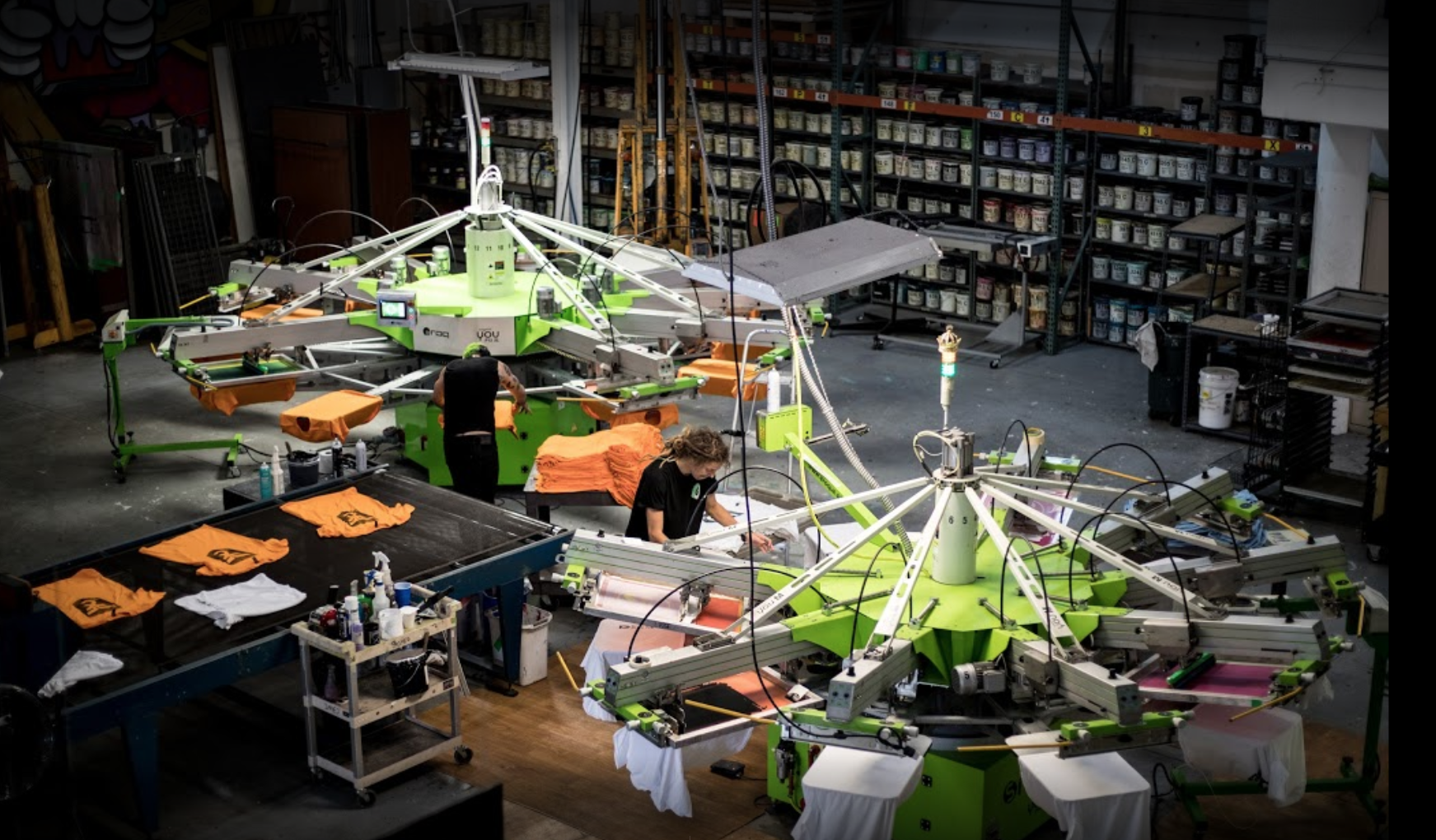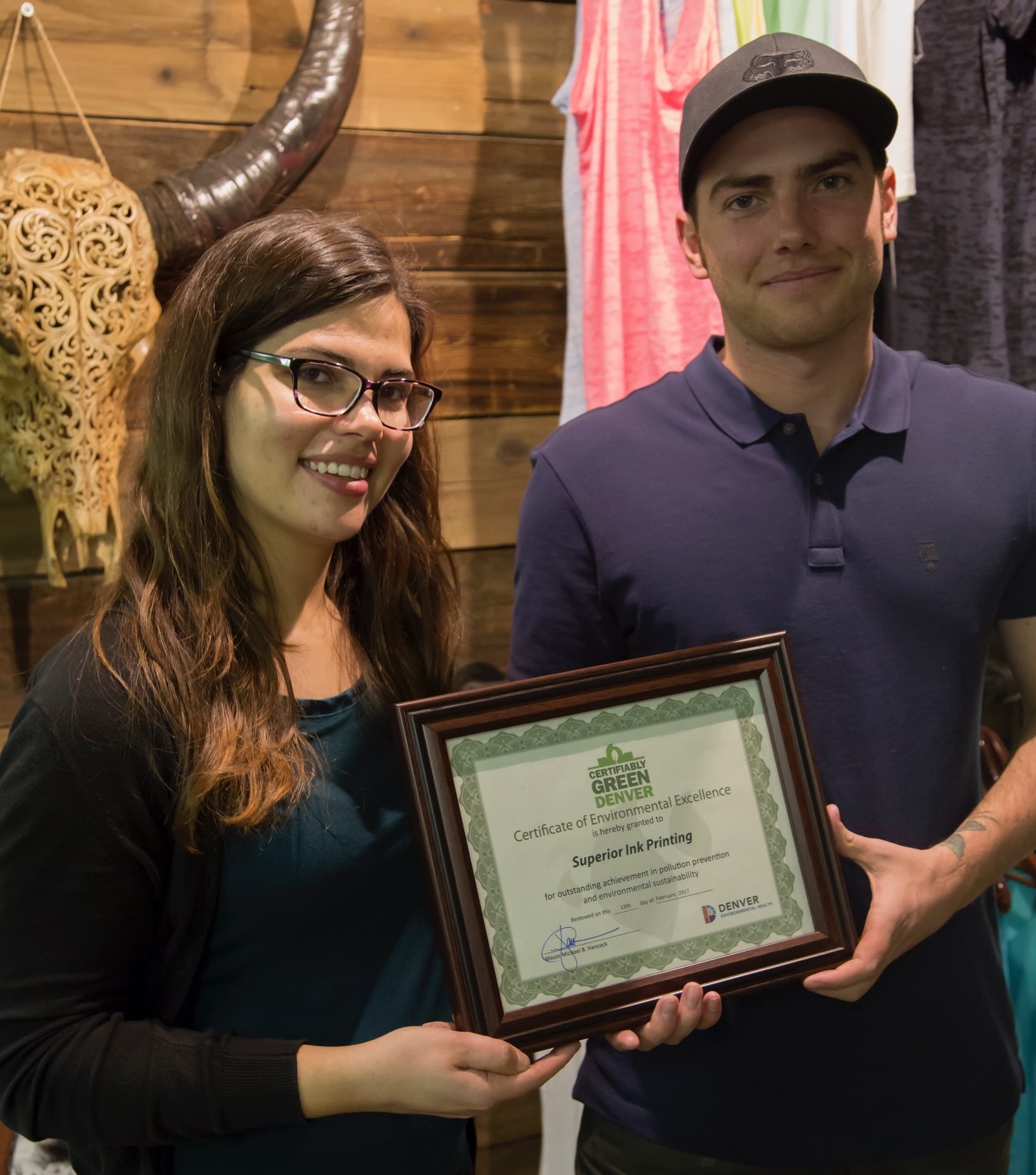Tips and How-To
Paving the Path to More Sustainable Screen Printing
The path toward more less wasteful manufacturing can seem overwhelming. But it isn’t.
Published
4 years agoon

FOR A SCREEN-PRINTING BUSINESS looking to improve its reputation, grow its customer base, and control costs, making the company more environmentally friendly might not immediately come to mind as a good strategy. But perhaps it should.
Customers are increasingly concerned about the environmental performance of print shops. Dominic Rosacci, CEO of Superior Ink Printing and a 2018 Screen Printing Rising Stars Award winner, has seen a surge of customers demanding high-quality, ethically sourced garments during the last two years. He is encouraged by this trend because he has positioned Superior Ink as an industry leader in sustainability and social responsibility.
The path toward more sustainable, less wasteful manufacturing can seem overwhelming. There are multiple aspects to consider, from materials choices and waste disposal to employee training on efficient practices. Switching from conventional to water-based inks isn’t straightforward.
Buying recycled materials often requires increasing the supply budget. Meeting regulations that vary from state to state can be confusing.
Certifications are one way to streamline a company-wide environmental audit. They define a prescribed path toward goals and offer recognition from peers and customers at the end of the process. By taking advantage of an established framework, businesses can evaluate their current practices and make changes that are in line with their company’s culture and resonate with their customers.
Various types of certifications are available and can cover a specific product or an entire company’s operations. The Sustainable Forestry Initiative (SFI) and Forest Stewardship Council (FSC), for example, certify wood and paper products. Print shops can choose to buy only paper that meets the chain of custody standards from SFI or FSC. These standards guarantee that materials are made from wood harvested from well-managed, certified forests. The chain of custody applies to every change of ownership and requires tracking from harvest through paper production and sale of the end product.
AdvertisementCompany-wide certifications are much more comprehensive. The cost ranges from free to tens of thousands of dollars per year. Some programs rely on self-reporting and offer a stamp or logo that isn’t especially meaningful. The most rigorous certifications require third-party verification and site visits to ensure that a company’s claims are valid.
These rigorous certifications require a substantial investment of time over several months or more, which means paying for employees or external consultants to implement the process, even if the certification itself doesn’t charge a fee. Going through certification often sheds light on opportunities to not only reduce a company’s carbon footprint but decrease expenses as well. For example, recycling and reusing solvents in-house reduces consumables costs and hazardous waste disposal fees.
Therefore, many businesses decide that devoting employee time to pursuing certification is financially a good move in the long run, especially if doing so gives them an advantage in the market.
The International Organization for Standardization (ISO) offers a dizzying array of standards, including several related to sustainability. ISO 14001:2015, Environmental Management System, requires businesses to develop and document a system but doesn’t specify exact performance requirements.
In industries where ISO 14001 certification is the norm, companies that ignore it risk losing reputation and market share. In the printing industry, where ISO 14001 certification is not common, most shops decide the time and expense of pursuing it is not worthwhile. Regional or industry-specific certifications usually offer a much better return on investment.
Regional Certifications
For print shops located in geographical regions where sustainability is a key aspect of the area’s culture, regional certifications provide a route toward building a local reputation. Superior Ink, based in Denver, took this approach when deciding to pursue the Certifiably Green Denver (CGD) certification. CGD promotes several benefits for certified businesses: automatic compliance with local and state regulations, cost savings from reduced resource use, enhanced reputation in the community, and recognition through free advertising.
AdvertisementCGD is free for local companies. It includes specific rules for six types of businesses, one of which is print shops. Print shops must meet criteria in five categories: business management, energy efficiency, water conservation, resource management, and transportation. The guidelines outline precise requirements such as using FSC or SFI certified paper and choosing either vegetable-based inks or conventional inks with low or no volatile organic compounds (VOCs). They suggest optional strategies including blending waste ink to create a “house black” for internal reuse. Rosacci says he appreciated that the city coached his company through the certification process and helped him see opportunities for improvement, such as packaging. His facility was going through hundreds of boxes of polyethylene (poly) bags per week for mailing shirts. They began buying supplies from EcoEnclose in Louisville, Colorado. EcoEnclose’s poly bags are made from 100-percent recycled content and come with a dual adhesive strip that allows them to be reused for customer returns.
Although CGD certification is free, meeting some of the standards required expenses that Rosacci wasn’t able to immediately justify. For example, replacing all the T-12 fluorescent bulbs in his warehouse with LED bulbs would have cost more than $50,000. Instead of replacing them all at once, he elected to replace a few per week. Other changes were easier to implement right away, such as training employees to shut off hot presses when they aren’t using them.
Rosacci says he’s proud to have achieved CGD certification and appreciates being a member of a community of like-minded businesses. “We’ve been able to build relationships that we wouldn’t have otherwise,” he says. Rosacci hopes that other print shops will follow his lead in obtaining certification.
He’s considering pursuing a state-level certification program that is more robust than Denver’s to further improve his environmental performance.

Various cities and states provide similar local certifications. Sustainability at Work in Portland, Oregon, has certified more than a dozen Portland-based manufacturing companies along with many nonprofits, architectural firms, and other businesses. Companies in western Washington can apply for EnviroStars certification through a program led by municipal governments and utilities, including Seattle and other cities in the greater Puget Sound area. Like the CGD program, requirements in Portland and Washington are industry specific.
AdvertisementLocal certification isn’t available everywhere, though, and for shops that operate facilities in several US states, managing multiple certifications or differing standards depending on location can be cumbersome. Such businesses will probably want to start by making changes at their headquarters and also consider other certification options.
Industry Certifications
The Sustainable Green Printing Partnership (SGP), which certifies the overall operations of a printing facility, is open to shops located anywhere in the country. SGP calls itself the “leading non-profit accreditation organization promoting sustainability in all printing processes” and encourages collaboration among printing shops, their customers, their suppliers, and associations that provide education and community outreach. To date, 53 printers in 20 states have earned SGP certification. DPrint in Florida is one of them.

Lisa Kaiser Hickey, DPrint chairman of the board, who recently retired from her role as president and CEO, explains the company’s decision to become one of the first SGP-certified printers in Florida. DPrint, then called Douglass Screen Printing, was already committed to lean manufacturing as a way to control inventory and waste; pursuing SGP was a natural next step. Hickey’s decision was made easier by the need to satisfy the requirement of one of DPrint’s largest clients, the US Government Publishing Office, which is an SGP-certified facility and gives SGP printers priority when competing for contracts. Still, being an early adopter allowed Douglass Screen Printing to stand out.
Achieving SGP certification requires considerable effort over a nine-month (or longer) period and continuing work to maintain certification, including biennial audits. In addition to tracking progress on waste management, energy use, and emissions via an online dashboard, printing facilities must lead an annual project. DPrint’s previous projects included changing out light bulbs for energy-efficient options, finding sources for recycling oils, and building a compost bin to compost coffee grounds on-site. This year’s project centers on employee safety, with a goal of keeping employees on the job and making production more efficient. Hickey is glad she pursued SGP and says, “Our employees have a business they’re proud of and that’s worth a lot.”
Advice from Printers
One question that plagues many businesses wanting to reduce their environmental impact: Do customers care? There’s a concern that customers are primarily focused on product quality and price – not whether a printer uses solvent-based or water-based inks or whether they print on recycled
substrates. But as more printers share stories of their sustainability journey, more awareness will build.
Both environmental awareness and action are accelerating with large businesses auditing their suppliers, including print shops. They want to buy from companies that are managing their waste streams, operating energy-efficient facilities, and treating workers well. “Nothing is 100-percent green,” says Rosacci. “What you can do as a business is give options to the customer and make sure you’re communicating with them.”
Print shops seeking to improve their environmental footprint and attract customers with stringent screening guidelines should start by evaluating where they are now and setting achievable goals for the future. Rosacci says, “Once you start making small changes, you don’t go back.” He emphasizes the important thing is to get started and trust the effort will pay off. Choosing a certification that fits your budget will provide the framework to evaluate your existing practices and determine which first steps to take. The certification process is designed to guide facilities through a process of continuing improvement. Certification doesn’t circumvent the effort needed to change a print shop’s policies and procedures, but it provides a map to follow. Also, the more shops that pursue certification, the more their suppliers will be pressured to provide affordable chemicals and supplies that support environmentally friendly practices. Things have been improving – Rosacci can buy ethically-sourced blank T-shirts at much better pricing than even two years ago – but there’s still a long way to go.
Hickey says print shops should ask themselves, “Do you want to be a great screen printer? Do you want to be a reputable screen printer? If so, you’re going to have to face up to these innovations in process management because that’s what it takes to go from good to great. There are no shortcuts.”
Julia L F Goldstein is the owner of JLFG Communications, producing white papers, articles, and other technical marketing content for companies manufacturing a wide variety of products. She blogs about materials and sustainability and is the author of “Material Value: More Sustainable, Less Wasteful Manufacturing of Everything from Cell Phones to Cleaning Products.”

SPONSORED VIDEO
Let’s Talk About It
Creating a More Diverse and Inclusive Screen Printing Industry
LET’S TALK About It: Part 3 discusses how four screen printers have employed people with disabilities, why you should consider doing the same, the resources that are available, and more. Watch the live webinar, held August 16, moderated by Adrienne Palmer, editor-in-chief, Screen Printing magazine, with panelists Ali Banholzer, Amber Massey, Ryan Moor, and Jed Seifert. The multi-part series is hosted exclusively by ROQ.US and U.N.I.T.E Together. Let’s Talk About It: Part 1 focused on Black, female screen printers and can be watched here; Part 2 focused on the LGBTQ+ community and can be watched here.
You may like
Advertisement

Inkcups Announces New CEO and Leadership Restructure

Hope Harbor to Receive Donation from BlueCotton’s 2024 Mary Ruth King Award Recipient

Livin’ the High Life
SUBSCRIBE

Bulletins
Get the most important news and business ideas from Screen Printing magazine's news bulletin.
Advertisement
Latest Feeds
Advertisement
Most Popular
-

 Art, Ad, or Alchemy1 month ago
Art, Ad, or Alchemy1 month agoF&I Printing Is Everywhere!
-

 Case Studies1 month ago
Case Studies1 month agoHigh-Density Inks Help Specialty Printing Take Center Stage
-

 Andy MacDougall1 month ago
Andy MacDougall1 month agoFunctional and Industrial Printing is EVERYWHERE!
-

 Columns2 weeks ago
Columns2 weeks ago8 Marketing Mistakes Not to Make When Promoting Your Screen Printing Services Online
-

 Editor's Note2 weeks ago
Editor's Note2 weeks agoLivin’ the High Life
-

 Thomas Trimingham2 months ago
Thomas Trimingham2 months ago“Magic” Marketing for Screen Printing Shops
-

 Marshall Atkinson2 weeks ago
Marshall Atkinson2 weeks agoHow to Create a Winning Culture in Your Screen-Printing Business
-

 News & Trends1 month ago
News & Trends1 month agoWhat Are ZALPHAS and How Can You Serve Them in Your Print Business?













